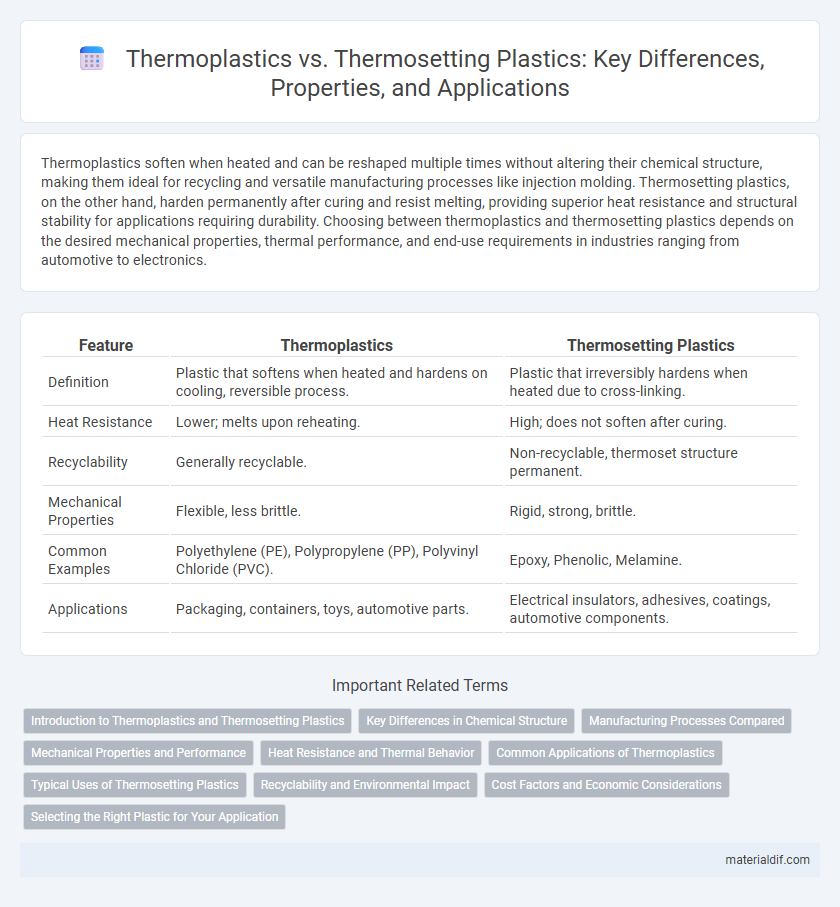Thermoplastics soften when heated and can be reshaped multiple times without altering their chemical structure, making them ideal for recycling and versatile manufacturing processes like injection molding. Thermosetting plastics, on the other hand, harden permanently after curing and resist melting, providing superior heat resistance and structural stability for applications requiring durability. Choosing between thermoplastics and thermosetting plastics depends on the desired mechanical properties, thermal performance, and end-use requirements in industries ranging from automotive to electronics.
Table of Comparison
| Feature | Thermoplastics | Thermosetting Plastics |
|---|---|---|
| Definition | Plastic that softens when heated and hardens on cooling, reversible process. | Plastic that irreversibly hardens when heated due to cross-linking. |
| Heat Resistance | Lower; melts upon reheating. | High; does not soften after curing. |
| Recyclability | Generally recyclable. | Non-recyclable, thermoset structure permanent. |
| Mechanical Properties | Flexible, less brittle. | Rigid, strong, brittle. |
| Common Examples | Polyethylene (PE), Polypropylene (PP), Polyvinyl Chloride (PVC). | Epoxy, Phenolic, Melamine. |
| Applications | Packaging, containers, toys, automotive parts. | Electrical insulators, adhesives, coatings, automotive components. |
Introduction to Thermoplastics and Thermosetting Plastics
Thermoplastics are polymers that soften when heated and can be reshaped multiple times without altering their chemical properties, making them ideal for recycling and various manufacturing processes such as injection molding and extrusion. Thermosetting plastics differ by undergoing a chemical curing process that creates a rigid, infusible structure, preventing them from melting upon reheating and providing superior thermal and mechanical stability for applications like electrical insulation and automotive components. Understanding the fundamental differences between thermoplastics and thermosets is crucial for selecting the appropriate material based on performance requirements and processing methods.
Key Differences in Chemical Structure
Thermoplastics consist of linear or branched polymer chains without cross-linking, allowing them to soften upon heating and be reshaped multiple times. In contrast, thermosetting plastics possess heavily cross-linked polymer networks that form irreversible bonds, resulting in a rigid, heat-resistant structure once cured. This fundamental chemical distinction impacts their thermal behavior, recyclability, and mechanical properties.
Manufacturing Processes Compared
Thermoplastics are manufactured through processes like injection molding and extrusion, where the material can be repeatedly melted and reshaped, allowing for efficient recycling and modification. Thermosetting plastics undergo curing during manufacturing via methods such as compression molding and transfer molding, resulting in a permanently hardened structure that cannot be remelted or reshaped. The manufacturing of thermosets typically requires longer cycle times and higher temperatures compared to thermoplastics, influencing production speed and product durability.
Mechanical Properties and Performance
Thermoplastics exhibit excellent flexibility and impact resistance due to their linear molecular structure, allowing them to soften and reshape when heated. Thermosetting plastics possess superior mechanical strength and thermal stability owing to their cross-linked polymer chains, which create a rigid network that cannot be remelted. Performance-wise, thermoplastics offer recyclability and repeated use potential, while thermosetting plastics provide enhanced chemical resistance and long-term dimensional stability under stress.
Heat Resistance and Thermal Behavior
Thermoplastics soften and melt upon heating, allowing them to be reshaped, but they typically have lower heat resistance, making them unsuitable for high-temperature applications. Thermosetting plastics undergo an irreversible curing process, forming strong cross-linked molecular networks that provide superior heat resistance and maintain structural integrity under elevated temperatures. Their thermal behavior makes thermosets ideal for components exposed to constant heat or harsh thermal environments.
Common Applications of Thermoplastics
Thermoplastics, known for their recyclability and flexibility, are widely used in packaging, automotive components, and consumer goods such as toys and household items. Materials like polyethylene, polypropylene, and polyvinyl chloride dominate these industries due to their durability and ease of molding. Their ability to be reheated and reshaped makes them ideal for applications requiring repeated processing and complex geometries.
Typical Uses of Thermosetting Plastics
Thermosetting plastics are commonly used in electrical insulation, automotive components, and adhesives due to their high heat resistance and structural rigidity. Phenolic resins serve as durable circuit board substrates, while epoxy resins are preferred in coatings and composite materials for aerospace applications. Their irreversible curing process provides enhanced mechanical strength, making them ideal for high-performance and safety-critical products.
Recyclability and Environmental Impact
Thermoplastics can be repeatedly melted and reshaped, making them highly recyclable and reducing environmental waste, while thermosetting plastics undergo a chemical change that prevents remelting, limiting their recyclability. The environmental impact of thermoplastics is generally lower due to their ability to be reused and reprocessed into new products, whereas thermosetting plastics often end up in landfills or require energy-intensive processes for disposal. Advances in recycling technologies for thermoplastics contribute significantly to sustainable plastic management and resource conservation.
Cost Factors and Economic Considerations
Thermoplastics generally exhibit lower production costs due to their recyclable nature and shorter molding cycles, making them economically advantageous for mass production and applications requiring frequent reshaping. Thermosetting plastics, while typically more expensive initially because of longer curing times and complex molding processes, offer superior heat resistance and mechanical strength, justifying higher costs in applications demanding durability and stability. The choice between thermoplastics and thermosets ultimately hinges on balancing upfront material expenses against lifecycle performance and production efficiency to optimize overall cost-effectiveness.
Selecting the Right Plastic for Your Application
Thermoplastics offer flexibility, recyclability, and ease of molding, making them ideal for applications requiring repeated heating and reshaping, such as automotive parts and packaging. Thermosetting plastics provide superior heat resistance, chemical stability, and dimensional strength, suited for electrical insulators, adhesives, and durable composite materials. Selection depends on application-specific factors like thermal exposure, mechanical stress, and product life cycle requirements.
Thermoplastics vs Thermosetting Plastics Infographic

 materialdif.com
materialdif.com